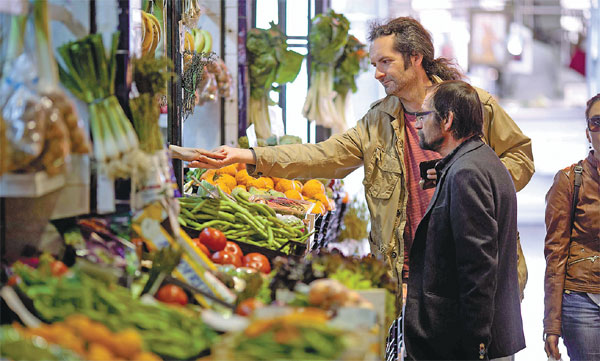Traversing seville
 |
|
Feria Market, one of the city's oldest, comprises two light-flooded buildings separated from the 13th-century Omnium Sanctorum Church by a narrow alleyway. |
Tapas crawl
In Seville, dinner is rarely a single-setting affair and a meal can stretch all the way across town and well past midnight. Begin at Casa Morales, a dusky, time-honored tapas joint in business since 1850, for a dish of salchicha al vino blanco, sausage cooked in white wine to juicy perfection (2 euros for a tapas portion).
Immense haunches of Serrano ham hang from the ceiling, and sardonic, battle-scarred barmen siphon wine from wooden barrels built into the wall. Next, head for Bodeguita Romero for a succulent pringa montadito, a toasted mini baguette sandwich of slow-cooked beef, chicken and sausage (2.50 euros for a tapas portion).
Finish at atmospheric Las Columnas, where your order is scrawled in chalk on the bar in front of you, and a convivial local-tourist mix washes down pinchito kebabs and Manchego cheese with cold glasses of Cruzcampo beer under the columns that are its namesake (about 6 euros for a beer and snack).
Floats and highballs
No Spanish city does Catholicism with quite as much gusto as Seville. During Semana Santa, or Holy Week, leading up to Easter, hundreds of thousands of believers flock here to witness the famous processions of pasos - floats bearing lifelike wooden sculptures depicting the Passion in all its rapturous detail - that take place throughout the city.
This fervor finds its campy, gin-soaked mirror image at El Garlochi, a velvet-draped haunt done up entirely in lavish church kitsch: brass candelabras, Madonna shrines, plastic funeral bouquets, oil portraits of weeping saints. Though it's been colonized by tourists in the past few years, the local crop of regulars - mostly gay men rakishly approaching middle age - can still be found nightly at the bar clinking highballs under a cloud of incense.
Moor fun
Seville is known for its stunning examples of the Mudejar style, an Islamic-Christian architectural hybrid most famously embodied here by the Alcazar, a royal palace that was once a Moorish fort. Last year, a permanent exhibition devoted to the style opened in the recently restored Palace of the Marquis of la Algaba, dating from the 15th and 16th centuries.
Known as the Interpretation Center of Mudejar Art, the modest English-translated exhibition puts the style into historical context, introduces the city's main Mudejar sites and includes pieces from the Archaeological Museum of Seville, as well as from several monasteries throughout the city. Entry is free.
















